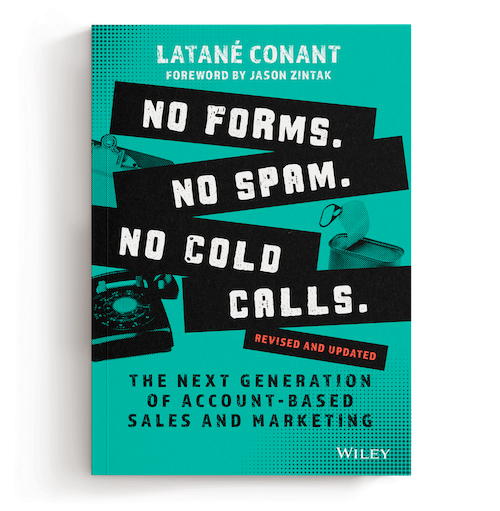Part 1 | From Zero2Hero: 13 Tech Capabilities You Need for Impact
Welcome to the tech capabilities you’ve always wanted. You know, like that catchy *NSYNC tune that just won’t quit? Much like JT’s glorious frosted tips from the 90s, this tech stack is all you’ll ever need (or want) to bring the heat to your B2B marketing game. Cue “All I Ever Wanted…” And yes, I know it’s “I Want You Back,” but I couldn’t get this song out of my head all day or the pop culture reference so… here we are.
This 3 part series dives into the must-have tech capabilities straight from Latané Conant’s insightful chapter, Building the Customer-First Tech Stack, in 6Sense’s book, No Forms. No Spam. No Cold Calls. Haven’t read this yet? Stop what you’re doing and GET IT NOW (for free)! It’s a game changer to how you approach marketing.
While we may be here to agree, disagree, or maybe just throw in our two cents, let’s talk about how you, modern marketer extraordinaire, can implement these tech capabilities. Whether you’ve got all the resources or are working with a shoestring budget and a cosmic dream, THIS IS THE WAY my Mandalorian marketers. We will do our best to help you pull these capabilities into your tech stack fold, but let me clear, this will not all be $Free.99, but IT 👏 IS 👏 WORTH 👏 IT 👏.
So without further ado here’s the lowdown about the first 4 tech capabilities you need to drive revenue:
Customer Data Platform
Let’s kick it off with the CDP (Customer Data Platform.) It’s all the rage these days, like the tech world’s version of avocado toast. Businesses are operating with massive quantities of Matrix-level data that puts a lot of stress on different systems, especially MAPs and CRMs. It’s like trying to power a house with all the appliances running at once. Imagine the hairdryer, dryer, AC, microwave, TV, and—oh yeah—your Scentsy, all at once on a handful of outlets. Short circuit, anyone?
That’s where CDPs step in. They help manage all that data in one nifty place, so you’re not overloading your systems. Here’s my 🔥 take, a CDP is great, but I’d argue you really need a DMP (Data Management Platform) for a complete picture. Otherwise, you’re just building a house of cards on a foundation made of jello. Start by aligning your data—contacts, companies, opportunities, the whole shebang—and then go deeper across your objects and systems.
PRO TIP: I highly recommend an internal universal record ID across your data universe TO HELP ASSOCIATE RECORDS TO THE RIGHT PLACE AND REDUCE DUPES.Intent Data
Now, let’s talk Intent Data. Latané drops a stat that should make every marketer sit up:
B2B buyers are already 70% of the way through their decision-making process before they ever talk to a salesperson. 🫳🎤Yep, that’s right. They’re hiding like they are in a high-stakes game of laser tag, and it’s on you to tag them before someone else, say your direct competitor, finds them and tags them down for the count.
Intent data helps you track those hidden buyers by capturing signals from both known and anonymous sources. Think of it as having night vision goggles in your marketing toolbox. You can spot the right opportunities at just the right time, leading to more opportunities which means more revenue.
Tracking intent sounds like the golden ticket and it would be, but no one wants to be stalked, especially online. So how do you track intent data without being Creeper McCreeperson? Especially as we go further along on our anti-cookie monster journey? As Ami Arad, Head of Evangelism at 6Sense, lovingly puts it, THIS is what the money is for. 💰
We get the WHAT & the WHY but not the HOW, and to be honest, most content I come across these days about this specific topic is just another bait and switch trying to sell me a new shiny silver ring that in the end just turns my digital finger green. THIS IS NOT WHAT THE PEOPLE WANT! Cue /pitchforks not /ponies.
Give the people something they want… ACTUALLY want where they are willing to provide their information first hand and feel they got something out of it for selling their digital soul. Other solutions I’ve heard tossed around are SSOs (like providing your Gmail or LinkedIn info… which may work for a time because it’s usually easy to do, but until people catch on that they are in fact giving away their personal info. Again bait + switch and not what the people want.
My homeboy Neil Patel (if you’re reading this, hi Neil, honored you’re reading my content) has a slamming dunk article about cookieless attribution and where to start because I could keep going now but it looks like this would be best saved for another day and another blog I should write. Sigh… so little time.
For the TLDR summary, intent is great where you can get it, but it’s past time to shift to a customer-first approach and pave a path for people who will willingly provide you with first party data (and continue to want to do so.)Account Identification
Account identification is like finding Waldo in a digital sea of red and white stripes. Matching the right company to the right intent can be tricky. Franchises, subsidiaries, people with mysterious IP addresses—it’s a whole thing. Even 6Sense is only nailing it 60-90% of the time. The tech is disruptive, but the investment can feel like putting your chips all in on a gravel road race.
But when it works, it’s the stuff marketing dreams are made of. And if you’re nerdy enough to get excited about 6Sense’s account matching patent (like yours truly), you’ll appreciate the deep tech behind it. Trust me—this isn’t your everyday capability in your stack.
There are few capabilities and tools that I will tell you that you need pay for but the reality is that this capability is a disrupter, but one where you have to use responsibly, especially where PII data is concerned. Building it internally can be done, but should it? It’s a behemoth of a project to take on that requires, you guessed it, our favorite, “a developer,” and a good chunk of money. Will it be as good as what is currently out there on there market? Sus, to say the least.
AI-Driven Predictions
Ah, AI—our futuristic overlord. AI-driven predictions take data and turn it into foresight. Like a marketing crystal ball, these models help you determine your Ideal Customer Profile (ICP), contact fit, campaign and channel spend, and which accounts are actually in the market. Call it black box magic, call it JedAI mind tricks but, also realize, yes, it is real… for a price, and you have to properly and consistently fuel the machine.
Predictive models can narrow down in-market accounts so you’re not wasting time chasing leads that will never convert. It’s about being smart with your time and resources—kinda like finding out you didn’t need to sit through that last season of Game of Thrones. You’re welcome. Unfortunately, like account identification, this is a tech stack super power that requires, you guessed it again, “a developer.” The silver lining though is that in most cases, if you think it, someone or something can build it, at scale.
Conclusion
This is just Part 1, folks! Latané knew what she was doing when she led with these top 4 capabilities, because they are the biggest hurdles and most expensive tech capabilities, but the ones with the most pay off. Stay tuned for the next part, which will hyper focus on data enrichment and acquisition, data segmentation, orchestration, and display advertising. In the meantime, I leave with you with *NSYNC jam.
Love what we’re laying down? Let’s journey together through the cosmos of marketing brilliance! Check out more insights on our Ops Scribbles Blog to help you elevate your marketing game to the stars. 🌌
This blog offers a witty and insightful response to Latané Conant’s chapter, Building the Customer-First Tech Stack, from the 6Sense book No Forms. No Spam. No Cold Calls. As the first part of a multi-part series, it explores the FIRST four of Thirteen tech capabilities marketers need to drive revenue—whether fully resourced or on a shoestring budget. Covering Customer Data Platforms (CDPs), intent data, account identification, and AI-driven predictions, this guide provides expert strategies for modern marketers to stay ahead. With practical insights and humor, this series helps you seamlessly integrate these essential tools into your tech stack. Get ready to elevate your marketing—AND IT is just the beginning!




